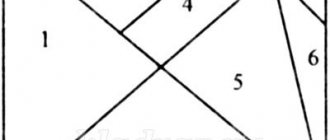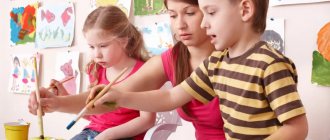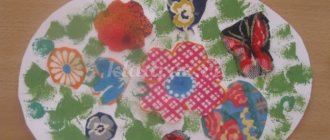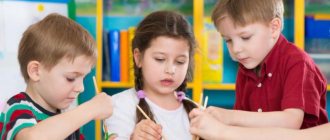Lesson summary in the educational field “Child and Society” on safety
Lesson notes on educational field
"Child and Society"
Topic:Purpose:
the formation of social experience and personal qualities of a child based on his inclusion in the system of social relations in various life and play situations.
Tasks:
— form ideas about special transport; develop the ability to comply with the rules of safe behavior; develop the ability to comply with the rules of safe behavior (from 3 to 4 years);
— consolidate ideas about special transport; to form ideas about the rules of conduct in emergency situations at home; to form ideas about places dangerous to life and health on the street, in the apartment (from 5 to 7 years)
— develop the ability to behave safely in potentially dangerous situations (from 3 to 7 years)
Materials:
safety stories, pictures of special vehicles, Clown toy.
Preliminary work:
conducting didactic games “Good - bad”, “You can - you can’t”, “Safety minutes”, excursions to the safety corner, conversations, looking at thematic illustrations and posters, learning physical education minutes.
Progress of the lesson:
Educator:
Hello children! Look, guys, who flew to us on balloons.
Children:
Clown.
Educator:
This is an unusual clown, he flew in on magic balls with numbers and letters written on them. But while he was flying, the balls got tangled up, help him collect them. To do this, you need to arrange the numbers in ascending order. We read in chorus what the word is.
Children:
Transport.
Educator:
Look carefully at the balls, what color are they?
Children:
Red, yellow, green.
Educator:
What do these colors resemble?
Children:
Traffic signals.
Educator:
That's right, well done! What you have learned is
Let me confirm for clarity: The traffic light guards Our safety. He is both polite and strict, He is known throughout the world, He is the main commander for transport on the wide street!
Educator:
How do you understand the word transport?
Children:
These are cars, bicycles, trams.
Educator:
On our street there are cars, cars, small cars, big cars. Hey cars, full speed ahead! Trucks are rushing, cars are snorting. They are in a hurry, rushing, as if they were alive. Every car has things to do and worries. Cars leave, go to work in the morning.
Educator:
There are a lot of vehicles. Let's look at the mode of transport that is closest to us. We classify cars that move on the ground as a ground mode of transport.
Educator:
Let's tell the Clown about them.
Which of these cars can you tell us about? (Children's stories).
The clown smiles, he is pleased with your stories.
Work according to the flowchart
Educator:
Ground mode of transport is divided into groups. There are special, public, passenger, and cargo. Why do you think they were called that and how do they differ from each other?
Children:
Trucks transport goods, and public passengers are specially designed to perform special work.
Educator:
Guys, which cars are classified as special cars?
Children:
Fire truck, ambulance, police car, gas service car.
Conversation about types of transport and their purpose
Educator:
That's right, well done! Guys, there are special cars that rush along, honking the entire street, without stopping at intersections. One says: “Ambulance.” Why does everyone miss this car? Because the patient must be taken to the hospital as soon as possible. By calling 103 we contact the ambulance service. And here comes another car, which is flying, overtaking everyone, and no one is stopping it. There is nothing written on it, but everyone recognizes it immediately, because only fire trucks are red as fire. The fire truck is allowed through without delay - the fire needs to be put out quickly before it burns the house. By dialing 101 we can call for fire assistance. Police officers receive a signal by number 102 when people's lives are in danger from criminals. Let's take notebooks and pencils, look, we have phone numbers written there, let's circle the numbers point by point and see what happens.
Game “Choose the right transport”
Educator:
The clown is tired and wants to play with you. On your desks there are pictures depicting some kind of vehicle. The clown shows emergency calls (101, 102, 103, 104), and you show the corresponding pictures. We call special vehicles in emergency cases. But more often in life we come across public transport. Public transport includes tram, trolleybus, metro, bus. The word tram came to us from England. “Trem” is a carriage running along the tracks, on rails. It moves due to the current that flows from the power station into the upper wire, from there into the arc of the tram and to the electric motor, which moves it. The current then travels through the wheels to the rails and returns to the power plant. A tram may have one, two, and sometimes three cars. As for the trolleybus, the word “bus” is an abbreviation of the word “omnibus” - a carriage for everyone. The word "trolley" means "contact wire". And the word bus means “auto” and “bus”, they come in different shapes. And in England it’s even two floors. The fastest public transport in big cities is the metro. The metro was first built in England, and in Russia it appeared in 1935 in Moscow.
Game “Prohibited - Allowed”
Educator:
Guys, the Clown had a question, do you know the rules of behavior in public transport? And let's play the game "Allowed - Forbidden." We will play the game with movements. Now you will see plot pictures, if the action depicted in the picture is allowed, you must clap, and if the action is not acceptable on transport, then you stomp your feet. You and I played, had a rest, and now we will continue our work. We have examined the ground mode of transport in detail, but there are other types of transport. Look at the screen and name what other types of transport you see here?
Children:
Ship, boat, motor ship - water. Airplane, helicopter, rocket - airborne.
Educator:
Right. Why do you think we need all these vehicles?
Children:
To ride them, to swim, to fly, to transport goods, people!
Educator:
But who controls all these machines?
Children:
Car - driver Rocket - astronaut Ship - captain
Educator:
Here in the pictures we see three types of vehicles. Tell me, did the transport choose its path correctly?
Children:
On an airplane we fly through the air. We are driving along the road by car. On a ship we sail across the sea, across the oceans!
Educator:
Now, let's play the game "What's extra?"
Children:
The magic carpet is superfluous.
Educator:
Oh guys, look what this track is? And our Clown is here. This, guys, is the path of knowledge, let's go along it and repeat how you remember everything. What did we talk about today? Let's hit the road. In order not to get bored on the way, let me tell you some riddles.
Not a bird, but flying, Not a bee, but buzzing. All the people who want to quickly - quickly he will take you home. (Airplane)
What type of transport is an airplane? What have we learned about this type of transport? (Children's answers).
Educator:
Well done! We can move on. Let's listen to the following riddle:
A steam locomotive without wheels! What a miracle - a steam locomotive! Has he gone crazy? He went straight across the sea! (Steamboat)
Educator:
Yes, that's right, what can you tell us about the ship? (Children's answers).
Educator:
Clever girls! Listen to the following riddle:
For this horse, food is Gasoline, oil, and water. He does not graze in the meadow, he rushes along the road. What is this? (Automobile)
Educator:
What are cars for? What type of transport does it belong to? (Children's answers).
Educator:
The clown smiles, he is pleased with your answers. Can you guess the next riddle?
A house goes down the street, taking everyone to work. Not on thin chicken legs, but in rubber boots. (Bus)
Educator:
Well done! The clown invites us to get on the bus and drive one stop. But the bus will not move until we tell you how to behave in transport. Let's repeat the rule, finishing the sentences with the words “allowed”, “prohibited”.
Educator:
When boarding a vehicle, enter the rear doors... (allowed)
And exit through the front... (allowed)
If you are traveling in public transport, and there are people around you, without jostling, without yawning, move forward as quickly as possible. Riding as a hare, as is known, ... (prohibited)
Giving place to the old lady... (allowed)
Leaning on the front door... (prohibited)
Sit on an empty seat... (allowed)
Leaning out of the window... (prohibited)
Talking and shouting loudly... (prohibited)
Educator:
You have shown the Clown your knowledge, we can hit the road. And so, the last stop, the bus stopped, but for some reason the doors did not open. In order for them to open, we must remember how to get around the bus?
Children:
We must wait for him to leave.
Educator:
Well done boys! The Clown and I really liked the way you worked, you were attentive and active. The clown was interested in the lesson and as a sign of gratitude he wants to give you his balls.






